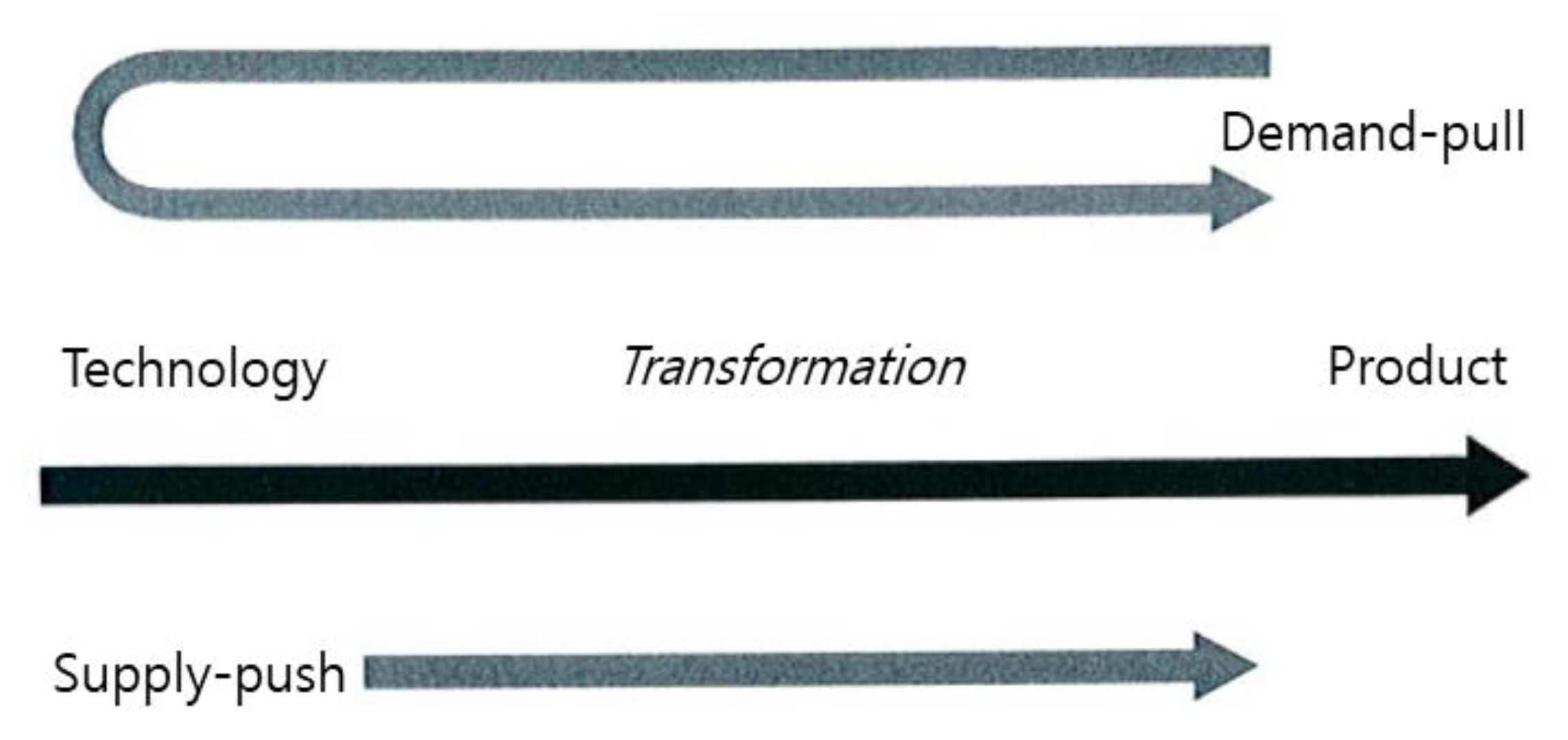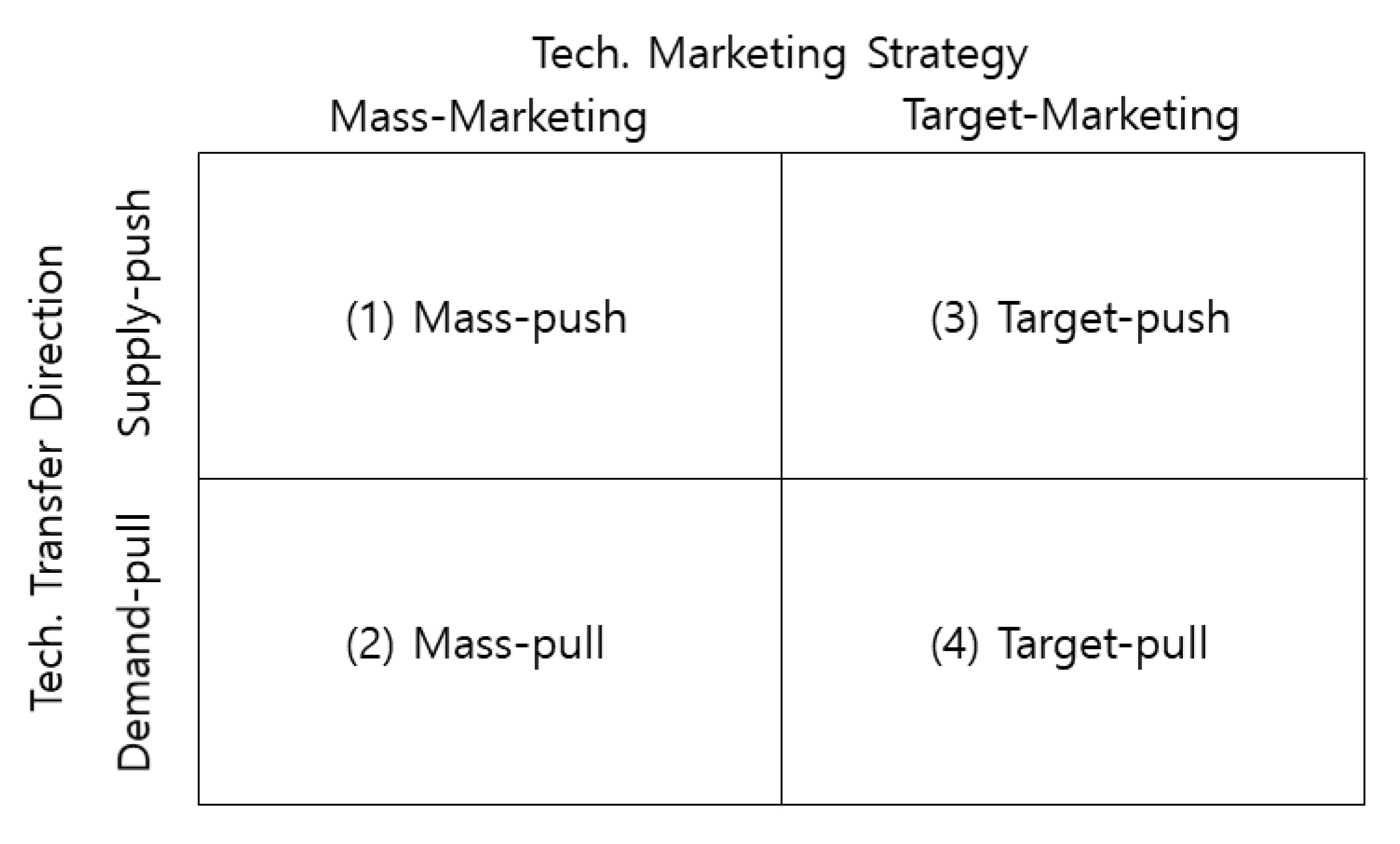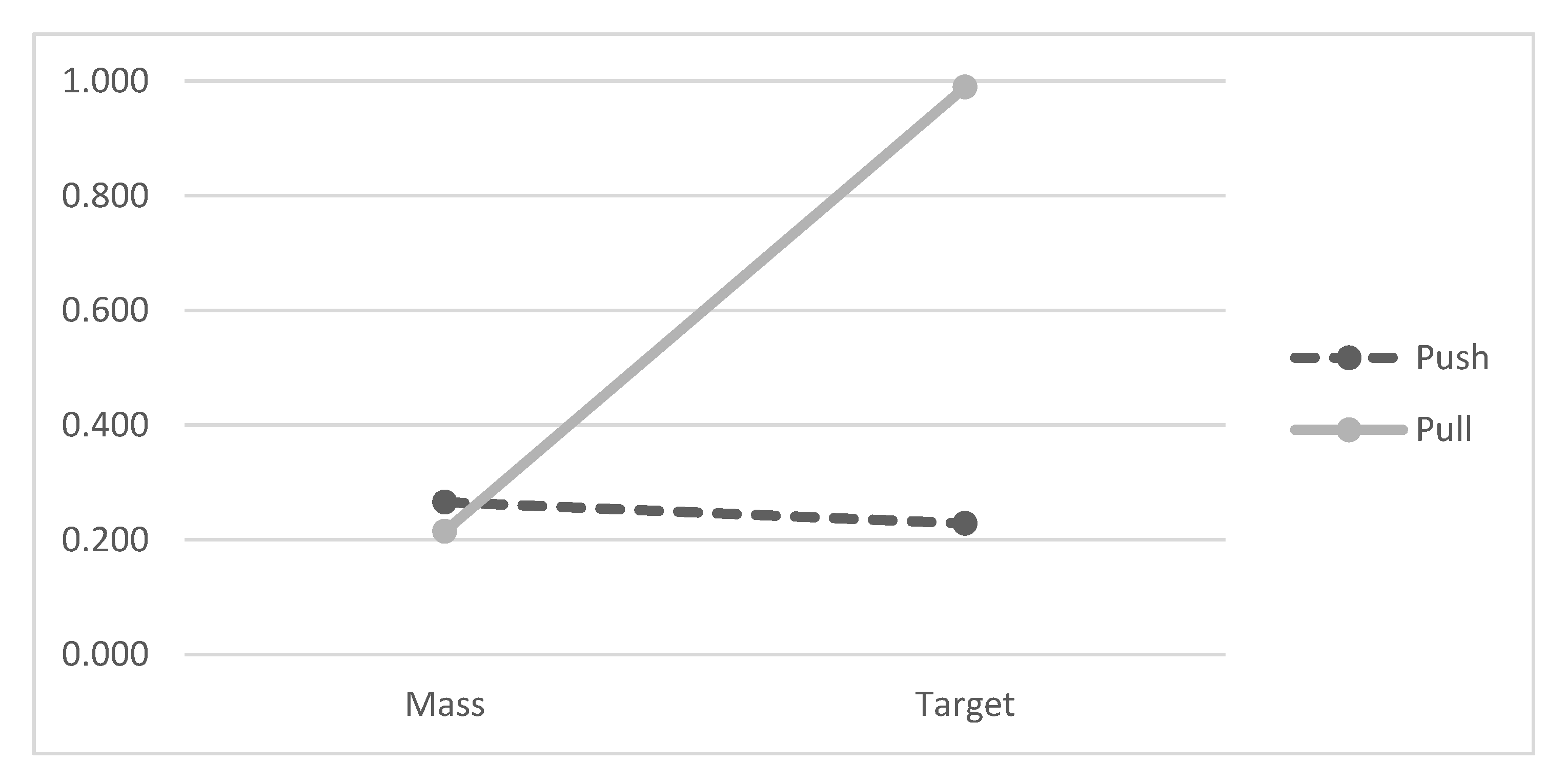3.1. Research Framework
Kotler & Armstrong [
39] suggest basic steps for a marketing strategy. Though their suggestions are for consumer markets rather than technology markets, Kotler [
40] argues that his concept of marketing can be applied to all organizations that have customer groups. For instance, the basic processes of marketing planning were applied to education [
41], nonprofits [
42], and technology markets [
43]. Kotler also suggests areas where marketing concepts can be used [
40].
According to Kotler & Armstrong [
39], there are four major steps in designing a marketing strategy: segmentation, targeting, differentiation, and positioning. These steps can be summarized into two large activities. The former two—segmenting and targeting—are selecting customers to serve, while the latter two—differentiation and positioning—are decisions based on a value proposition. In other words, defining a market and defining a product are the main elements in designing a marketing strategy.
In technology transfer, the supply-push and demand-pull models that are discussed in the previous section can be related to the latter step—defining a product or defining value proposition activities. As we reviewed in the previous section, being supply-push or demand-pull is about who defines the attributes of technology that are important to the purchase decision [
14], and when that definition is made. The users of the technology define the attributes in the demand-pull model and suppliers determine those in the supply-push model.
Regarding the market side, there can be several approaches in selecting and targeting market segments. According to Kotler & Armstrong [
39], there can be four levels of marketing strategies: mass marketing, differentiated marketing, concentrated marketing, and micromarketing. While mass marketing ignores market segment differences and targets whole markets with a single offer, the latter three consider the differences between customers and target-specific groups or individual customers. In our study, we summarize them into mass-marketing and target marketing strategies. These segmentations can be applied to technology transfer.
The previous section shows that the administrative or the marketing models replaced the traditional legal model. The latter two models actively use marketing methods, but there are some differences. While the marketing methods in the administrative model tend to be limited to mass advertisement, the marketing model does not usually use advertising in an effort to limit curious inquiries and conserve staff time and energy, and it relies more on market segmentation to identify the potential users of technologies [
16]. It means that there may be different marketing strategies for technology transfer practices.
Summing up the discussion above, we can establish a research framework that combines the dimensions of technology transfer direction and technology marketing strategy, as illustrated in
Figure 2. Two technology directions (supply-push and demand-pull) and two marketing strategies (mass-marketing and target marketing) yield four different types of technology transfer: (1) mass- push, (2) mass-pull, (3) target-push, and (4) target-pull.
3.2. Hypotheses
We hypothesize that TTPs are different, depending on the technology transfer directions and technology marketing strategies. First, we propose that the supply-push and the demand-pull models produce different TTPs. The core difference between supply-push versus demand-pull models is who defines the attributes of technology and technology transfer [
14]. Suppliers define the attributes of supply-push technology transfer (who are far from the market), and users define those of demand-pull (who are closer to the market). In the case of supply-push technology transfer, there can be a higher level of risk and uncertainty from the users’ perspective, and users can be reluctant to adopt the technology. Conversely, as the users of technologies generally have more market knowledge, a demand-pull technology transfer, whereby users define the attributes, may carry less risk and uncertainty in commercialization, and users may eager for the transfer of the technology. These factors may have an influence on the bargaining power of suppliers and users, and therefore TTP may be different according to the direction of the technology transfer.
Some recent studies regarding this topic also reveal that TTPs that consider demand are better for performance. Yang and Kim [
44] examine the problems that are suffered by R&D organizations and show that difficulties in evaluating the market value of technology are one source of the difficulties. Their study implies that market demand is important for technology transfer. Reflecting this implication, Hwhang and Chung [
15] analyzed some technology transfer cases at a Korean research institute and argue that TTP may be better when the technology transfer processes are based on the needs of potential users.
Hypothesis 1. TTPs differ by technology transfer direction.
Mass-marketing and target marketing strategies may also produce different TTPs. In a general marketing setting, mass marketing and target marketing have advantages and disadvantages [
39]. Using a mass marketing strategy, the firm may enjoy a large number of customers at relatively low cost, but they may suffer from the disadvantage that the firm’s product or brand can experience difficulties in meeting customer needs, which causes customers to turn to other products. On the other hand, the firm using a target marketing strategy may have a stronger position in the market, as they are the right supplier for a specific group of customers, but target marketing incurs costs and increases risk if the firm only relies on one segment of the market. According to Kotler & Armstrong [
39], most modern marketers believe that a more differentiated marketing (or target marketing) plan entails better performance.
Similarly, there can be advantages and disadvantages of mass marketing and target marketing in technology transfer [
14]. By taking a mass-marketing approach, technology suppliers can present their offerings to a larger and wider range of potential technology users, but there may be difficulties in finding the right match in such a large number of users. The target marketing approach may reduce the risk of technology adoption by offering the right technologies to the right users, but target marketing requires extensive market analysis, which incurs costs.
There are some empirical studies regarding user targeting for technology transfer. Seok et al. [
45] show that identifying potential users of technology is important for technology transfer. They first selected a technology that was developed by a Korean research institute that had not been transferred for several years, despite the institute’s efforts to license it out. They conducted a patent citation network analysis to find the user firms with the highest potential, on the basis of path dependence in technological progress. Later, their approach proved to be correct, as the technology was successfully licensed out. Park et al. [
46] conducted a similar approach with Seok et al. They found that identifying and targeting specific groups of customers (using patent citation analysis) were useful for specific types of technologies.
Hypothesis 2. TTPs differ by technology marketing strategy.
In the demand-pull model, the attributes of technology transfer are defined and/or requested by users. If the supplier of technology has capabilities for the attributes and is ready to respond to the request, then the technology can be ready for transfer. If the supplier has approached the potential user firms by market segmentation and targeting, they might be better prepared for the needs of user firms. It is then possible that the demand-pull model produces better performance when used together with target marketing.
In the supply-push model, suppliers define the attributes of technology transfer. Suppliers define attributes and initiate technology transfer because industry players either lack market knowledge, and hence awareness, of the existence of appropriate technological developments, or else their technological capabilities are insufficient to create demand [
35]. Subsequently, it may be needed for a supplier of technology to explore a wider range of opportunities. For this reason, it is possible that the supply-push model can be more effective when used with mass marketing.
Therefore, we also suggest that technology transfer direction and technology marketing strategy jointly influence TTP. We offer the next hypotheses, as below.
Hypothesis 3. TTPs are influenced by the interaction between technology transfer direction and technology marketing strategy.
Hypothesis 3-1. For the supply-push direction, TTPs differ by technology marketing strategy.
Hypothesis 3-2. For the demand-pull direction, TTPs differ by technology marketing strategy.
3.3. Research Method
For this study, we collected technology transfer data from a research institute in Korea (“K Institute”). The K Institute was founded in 1989 as an affiliated institute of the Ministry of Commerce and Industry. The institute aims to strengthen the capabilities of small- to medium-sized enterprises (SMEs) to support sustainable growth in the country’s manufacturing industry. The functions of the institute include developing technologies that are commonly needed by SMEs; investing in demand-oriented R&D for manufacturing technologies; assisting SMEs in utilizing technology, human resources, and infrastructure; and, technology transfer and diffusion. As the K Institute aims to support SMEs, it has about 12 sites that are distributed around the country.
The characteristics of K Institute can be summarized as a focus on SMEs and manufacturing (especially process) technology, and geographically dispersed locations. Due to these characteristics, this study does not need to consider other factors that influence technology transfer, such as user characteristics [
25], technological characteristics [
47], geographical proximity [
48], etc. The institute specifically works with SMEs, especially in the manufacturing (especially process) technology area, so the user characteristics and technological characteristics are not very diverse. As it has about 12 sites in major industrial complexes in the country, geographic distance to user firms is not a significant issue.
The K Institute offers technology transfer in the forms of licensing, disposal (sales), investment in technology, mergers and acquisitions (M&A), etc. Among these forms, we only collected licensing cases. A majority of the institute’s technology transfer agreements are licensing (according to the technology marketing team of the institute); WIPO (the World Intellectual Property Organization) also notes that technology transfer is “generally effected by means of IP licensing agreements” [
49].
The collected data covers K Institute’s technology licensing agreements during 2014–15, and each sample contains a title for the transfer project, a licensing fee, and a title of R&D program or project (by which the technology was developed). Initially, there were 704 samples. We excluded six samples that had missing information and analyzed a total of 698 cases of technology licensing.
The 698 samples were categorized into the four types of technology transfer in
Figure 2: (1) mass-push, (2) mass-pull, (3) target-push, and (4) target-pull. For this task, we set some criteria, as shown below, and consulted the K Institute’s technology marketing team.
- (1)
Mass-push: Cases in which technologies (usually developed from top-down R&D programs) were transferred off the shelf via mass-marketing channels, such as mass announcements, catalogues, exhibitions, etc. For example, there were cases of transferring technologies that were developed under government-planned R&D, which can be broadly used in many industry sectors, or they were developed without clear marketing perspectives and stayed on the shelf.
- (2)
Mass-pull: Cases in which opportunities for technology transfer were announced via mass-marketing channels and firms accessed those opportunities. In many cases, the technologies were modified, customized, or further developed to fulfill the specific needs of technology users. For example, the K Institute announced an SME-supporting program via mass-marketing channels (without specific targets or segmentation), and some SMEs approached the program. The K Institute identified the technical problems of the firms, developed new technologies or modified existing ones, and transferred the technologies to the firms.
- (3)
Target-push: Cases in which the K Institute developed technologies for a specific industry segment, designed specific offers for each segment, and licensed them in an off-the-shelf manner. For example, cases from K Institute’s Platform R&D Program fall into this category.
- (4)
Target-pull: Cases in which K Institute segmented a market and targeted a specific segment. The institute surveyed or examined the needs of a specific segment and developed technologies or prepared technology transfer for the segment according to the needs or requests of the firms in the segment. In many cases, technologies were modified, customized, or further developed to fulfill the specific needs of technology users. For example, K Institutes’ order-based technology transfer programs fall into this category.
For TTP, we attempted to use two measures: technology license fees in South Korean local currency (KRW) and R&D productivity. The technology license fees were drawn from individual technology transfer cases. The R&D productivity measure was calculated by dividing the technology license fee by the direct costs. However, as it is difficult to measure direct R&D costs for each individual technology transfer case, we summed up the license fees of technologies in the same R&D project and divided the total license fees by the direct cost of the R&D project.
We employed a two-way ANOVA to analyze the data and test the hypotheses. As we compared the TTPs (measured by license fees and R&D productivity) by the groups of technology transfer cases that are shown in
Figure 2, we used two-way ANOVA instead of other methods.
Our analysis was undertaken in two stages. In the first stage, we used the full data set (698 samples). In the second stage, we excluded some samples from the full data set. Among the samples in the full data set, there are some cases in which the technology license fees are notably higher than others. These cases fall into one of the four types of technology transfer in our framework. As these may cause some problems in analysis, we performed another analysis after excluding them.










